JUMP TO SECTION
Data-Driven Hiring | Hiring Best Practices
AI for High-Volume Tech Hiring: Screen Developers 10x Faster Without Losing Fit
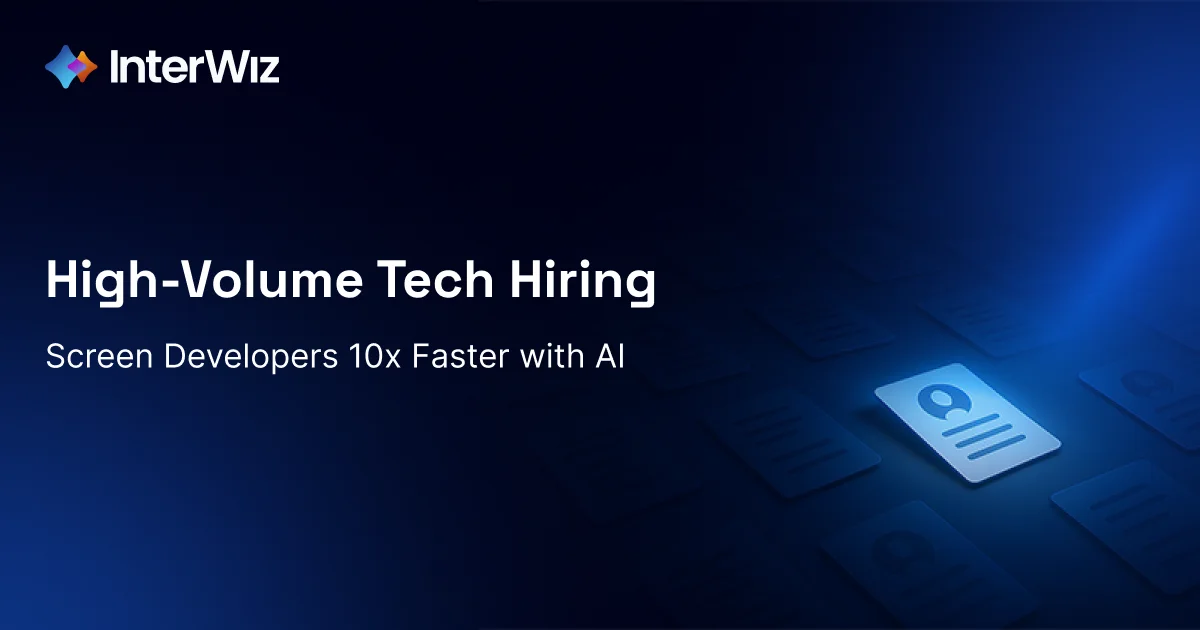
AI screening tools helps recruiters cut resume review time from 10–15 hours to minutes, without losing developer fit. The core problem is scale: more applicants don’t mean better hires, just more manual work and drop-offs.
Recruiters often spend 2–3 minutes per resume when screening developers, which adds up fast in roles attracting hundreds of applications. This results in delayed feedback, frustrates candidates, and lets faster-moving competitors win the best talent.
AI candidate screening addresses this by automating resume parsing, coding assessments, and early-fit checks. Instead of getting buried in repetitive screening, recruiters start with a ranked shortlist aligned to job requirements and cultural needs.
For staffing agencies and tech teams, this means faster hiring cycles and more bandwidth to focus on engaging top developers before they walk away.
Key Takeaways:
AI hiring enables recruiters to screen developers up to 10x faster, but speed only translates into value when fairness, transparency, and candidate fit are built into the process.
High-volume tech hiring works best with a hybrid model, AI screening handles scale and repetition, while recruiters bring judgment, context, and cultural evaluation.
InterWiz bridges the gap by combining AI-powered assessments with structured interviews and analytics, helping teams move from thousands of applications to consistent, data-backed hiring decisions.
The Core Problem in High-Volume Tech Recruiting
Recruiters face three main challenges in high-volume developer hiring: speed, accuracy, and a positive candidate experience. Manual resume screening fails to ensure these three key items, resulting in longer and inefficient hiring cycles and missed opportunities.
Without AI candidate screening, the hiring teams face the following issues:
The quality-quantity paradox: Hundreds of applications look like a healthy pipeline, but many are unqualified. Recruiters spend 2–3 minutes per resume, adding up to 10–15 hours per role, while qualified candidates risk being overlooked.
The resource crunch: Recruiters get swamped with manual screening, scheduling, and constant updates. This overload means they have less time to focus on the important stuff, like connecting with candidates and making smart hiring decisions.
The race against the clock: In competitive markets, top developers can be hired elsewhere in as little as 10 days. Slow feedback and drawn-out processes frustrate candidates and lead to drop-offs.
The risk of inconsistency and bias: Under pressure, different managers apply different criteria. Without standardized evaluations, fairness becomes difficult to maintain across high-volume pipelines.
The takeaway is that scale itself becomes the obstacle. To move forward, companies need a lever that restores speed, accuracy, and fairness simultaneously, and that’s where AI screening tools come in.
How AI Enables Faster Developer Screening Without Compromising Quality
Screening developers manually is slow and inconsistent. Recruiters spend hours reviewing resumes and still risk overlooking strong candidates due to keyword mismatches or fatigue. The result: challenges in high-volume hiring and missed opportunities for top talent.
AI-driven screening changes this dynamic by automating the repetitive tasks of parsing resumes, mapping skills, and enriching candidate profiles with contextual data. Instead of rushing or sacrificing quality, recruiters get a faster, more accurate shortlist built on skills and job relevance.
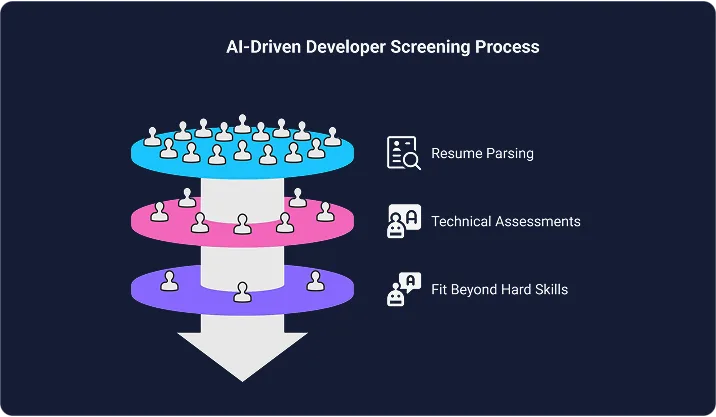
Here are three key ways AI screening tools help recruiters reduce manual labor:
1. Resume Parsing and Skills Extraction
Manual resume reviews force recruiters to sift through hundreds of applications, scanning for technical skills, education, and work history. The process is slow, repetitive, and inconsistent. Strong developers often slip through if their resumes don’t use the exact keywords in the job description.
AI resume parsing solves this by using natural language processing (NLP) to understand resumes in context. Instead of filtering only by keywords, it recognizes synonyms, related skills, and phrasing variations, ensuring qualified developers aren’t overlooked.
Here's how AI screening tools improve developer resume parsing:
Resume Parsing with Context: Advanced AI screening tools apply deep search on keyword matches. They use NLP to recognize synonyms, related skills, and contextual phrasing. For example, A resume says “built REST APIs” while the job description asks for “API development.” A basic keyword search might miss this, but NLP-powered parsing understands they mean the same thing.
Skill Mapping: NLP models analyze statements and phrases in resumes and map job requirements to candidate skills, even if the language doesn’t align perfectly. For example, “Designed scalable microservices” is recognized as backend development experience, even if “backend developer” isn’t explicitly listed.
Entity Recognition: They identify important data points (technologies, programming languages, degrees, certifications) even if listed in varied formats. For example, “B.Sc. CompSci” is read as “Bachelor’s in Computer Science,” ensuring qualified candidates aren’t excluded by formatting differences.
For staffing agencies and tech recruiters, this means fewer hours wasted on manual reviews and a sharper, fairer shortlist that highlights the best developer candidates.
2. Automated Technical Assessments
Recruiters often spend hours manually reviewing coding tests, debugging tasks, or portfolio projects. At high volumes, this process becomes a bottleneck, slowing down hiring decisions and creating inconsistent evaluations across candidates.
AI-driven technical assessments solve this by automating test creation, grading, and benchmarking. They provide real-time insight into coding ability, reduce manual workload, and ensure that only technically capable developers move forward.
How AI-driven screening streamlines technical assessments:
AI Coding Tests & Auto-Grading: AI screening platforms automatically generate and grade coding challenges, debugging tasks, and role-specific exercises. This eliminates hours of manual review and produces instant, standardized results. For example, a recruiter running a JavaScript coding test for 200 applicants receives auto-graded results within minutes instead of spending days manually checking code.
Adaptive Testing: Skill assessments adjust difficulty in real time based on candidate performance, giving a more accurate measure of skill level. For example, a developer who quickly completes a mid-level Python task is automatically given an advanced challenge, helping recruiters benchmark seniority more precisely.
Plagiarism & Cheating Detection: AI screening tools monitor typing patterns, code similarity, and time spent on questions to detect dishonest behavior.
Skill Benchmarking: Results are mapped directly to job requirements and compared against standardized data, giving recruiters clear, actionable insights.
Platforms like InterWiz, HackerRank, and Codility provide real-time insight into coding ability, reduce manual workload, and ensure that only technically capable developers move forward.
3. Fit Beyond Hard Skills
Manual coding tests can confirm whether a developer knows a language or framework, but they rarely reveal if that person can communicate clearly, adapt under pressure, or collaborate within a team. This gap often leads to technically strong hires who fail in real-world environments.
AI-powered interview platforms address this by extending screening beyond hard skills. They evaluate communication, track behavioral signals, and surface cultural alignment, giving recruiters a more complete view of candidate potential before final interviews.
How AI tools extend screening beyond hard skills:
AI Communication Analysis: Measures how clearly candidates explain their reasoning and problem-solving approach, ensuring technical ability is paired with the ability to collaborate effectively.
Collaboration and Behavioral Cues: Tracks adaptability, responsiveness, and handling of pressure during live or simulated tasks, helping recruiters predict how candidates perform in team-based environments.
Structured Interview Insights With InterWiz: Provides transcripts and analytics from structured interviews, highlighting both technical performance and communication patterns. This helps recruiters assess cultural alignment alongside coding ability.
External Data Enrichment: Pulls in context from platforms like GitHub or LinkedIn to show real-world collaboration, open-source contributions, and career progression, offering a broader view of candidate potential.
For recruiters, this means building shortlists that balance technical excellence with the soft skills that drive long-term team success.
Comparing Manual vs. AI Screening in High-Volume Tech Hiring
Manual screening slows mass hiring cycles; AI tools accelerate them without cutting quality. When developer roles attract hundreds of applications, the differences between the two approaches become clear.
The contrast shows up most in five areas that really matter to recruiters:
Criteria | Manual Screening | AI Screening |
Speed & Scalability | 2–3 minutes per resume = 10–15 hours for 300 applicants. Bottlenecks scale poorly. | Parses hundreds in under a minute each, enabling thousands of applicants without extra headcount. |
Accuracy & Bias | Fatigue, inconsistent criteria, unconscious bias (names, schools, backgrounds). | Uniform evaluation, learns over time via machine learning; still requires oversight to prevent bias. |
Cost Efficiency | High labor costs, delayed hiring, turnover from poor fits increases expense. | Initial investment, but lowers costs long term by reducing manual work and improving hire quality. |
Candidate Experience | Often slow and inconsistent, leading to drop-offs; limited communication. | Faster responses, structured evaluations, transparent feedback; can feel impersonal if over-automated. |
Nuanced Skills | Strong: recruiters excel at assessing soft skills, team fit, and leadership traits. | Limited: struggles to capture cultural fit and emotional intelligence without recruiter input. |
The takeaway: manual methods can’t keep pace with high-volume hiring, but a hybrid approach works best. AI tools handle scale and objectivity, while recruiters bring judgment and nuance to final decisions.
Does AI Tools Risk Hiring the Wrong Developer in High Volume Recruiting
Yes, the use of AI screening tools absolutely risks hiring the wrong developer if it’s used without significant human oversight. The technology is powerful for streamlining high-volume hiring but is limited by its training data and its inability to assess human qualities like creativity, critical thinking, and cultural fit.
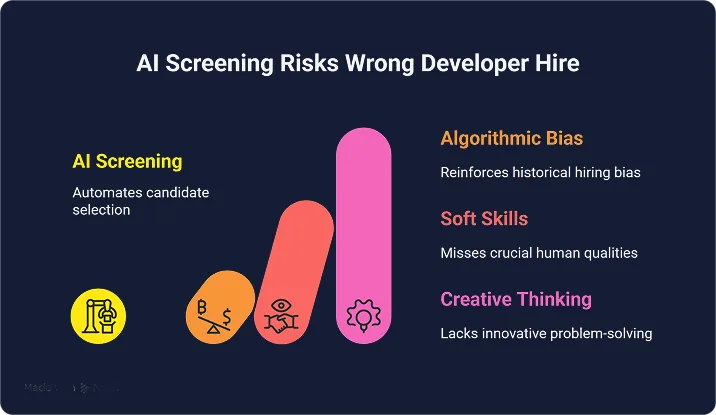
To understand where AI resume screening can go wrong, let’s break down its primary risks:
Algorithmic Bias
AI models learn from the data they’re trained on. If historical hiring data reflects past bias, for example, a company disproportionately hiring male developers, the system may reinforce those patterns.
Real-world case: In 2018, Amazon scrapped an AI recruiting tool because it penalized resumes with the word “women” and downgraded graduates of women’s colleges. Trained on a decade of male-dominated resumes, the model amplified existing inequalities.
The consequence: Biased AI-driven screening risks excluding underrepresented talent, undermining diversity, and stalling innovation.
Inability to Assess Soft Skills and Cultural Fit
AI hiring tools can excel at measuring technical ability, but they struggle with communication, teamwork, and leadership potential. These skills are often revealed through nuanced conversation and context, which algorithms can’t replicate.
The consequence: A developer with strong coding skills but poor collaboration habits could disrupt team morale and productivity. A purely AI-driven hiring process may advance this candidate while overlooking the damage to culture.
InterWiz advantage: Unlike coding-only tools, InterWiz supports structured interviews with transcripts and analytics. This ensures recruiters capture communication style, problem-solving, and cultural alignment alongside technical assessments.
Lack of Creative and Adaptive Thinking
AI screening tools generate code and solve problems within known patterns, but they cannot make intuitive leaps or adapt to ambiguous challenges. For example, while an AI tool can efficiently debug a known error in a software program, it might struggle to innovate a new solution when faced with an unprecedented problem that requires creative thinking.
The consequence: Companies relying solely on AI tools inevitably hire developers who perform well on defined tasks but lack creativity, resulting in technical debt and slower innovation.
How to Mitigate the Risks
Human-in-the-loop: Use AI tools to automate repetitive tasks like resume screening and scheduling, but leave final evaluation and interviewing to recruiters.
Regular bias audits: Audit algorithms internally or with third parties to ensure fairness. Jurisdictions like New York City now mandate bias audits for AI hiring tools.
Holistic, evidence-based evaluation: Combine AI screening with structured interviews and standardized scorecards to assess both technical and soft skills fairly.
AI tools can misfire, but when paired with oversight, audits, and structured evaluations, they become a lever for efficiency without sacrificing fairness or fit.
AI Screening in High Volume Recruitment: Real-World Proof & Results
Companies across industries have tested AI in high-volume hiring, and the results are measurable. Faster cycles, lower costs, and stronger diversity outcomes show how AI-driven hiring delivers real impact when paired with human oversight.
Here are some standout results:
Unilever: Faced with 250,000+ applications annually, Unilever cut its time-to-hire for entry-level roles from 4 months to just 2 weeks, while also improving workforce diversity by 16%.
Hilton: To manage thousands of candidates across global locations, Hilton deployed an AI-powered chatbot that reduced time-to-fill by 50% and lifted candidate satisfaction to 83%.
IBM: Using Watson AI screening to analyze resumes and skills, IBM saw a 30% increase in hire quality and a stronger representation of women and minority candidates.
Vodafone: Handling more than 50,000 applications per year, Vodafone reduced time-to-hire by 50% and improved the quality of its shortlists through AI video interviews and screening.
Intel: To improve representation, Intel applied AI to detect and remove biased language from job descriptions, helping the company reach its goal of full workforce representation in the U.S.
Results from leading brands show that while AI tools speed up high-volume screening, achieving true efficiency requires managing the entire recruitment process. InterWiz supports recruiters from high-quality sourcing to structured interviews, skill assessments, and analytics. This ensures faster shortlists without losing visibility into communication, collaboration, and cultural fit.
Practical Steps to Implement AI in High-Volume Developer Hiring
AI hiring tools can transform developer screening, but only if recruiters adopt them deliberately. Here’s a structured approach to implement AI-driven hiring so it speeds up screening without hurting fairness or candidate experience.
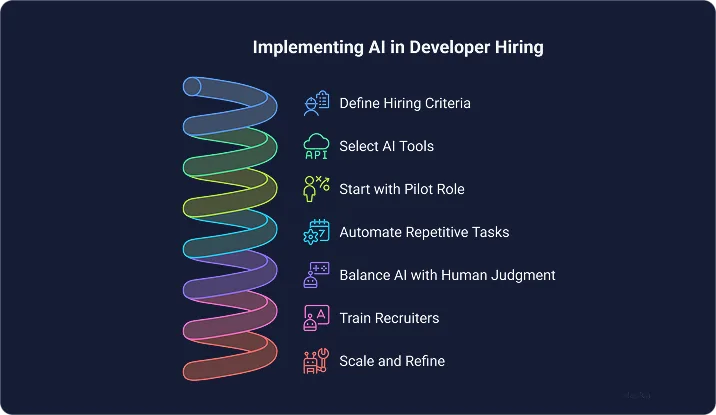
Define hiring criteria clearly: Clarify the coding languages, frameworks, years of experience, and soft skills that matter most. This ensures AI tool surfaces relevant candidates instead of overwhelming recruiters with mismatches.
Select the right AI tools: Evaluate hiring platforms with AI features, coding platforms like HackerRank or Codility, and AI interviewers such as InterWiz. Choose solutions that integrate with your current recruitment process and provide transparent scoring.
Start with a pilot role: Test the AI hiring tool on a single high-volume role before rolling it out widely. Running the new process in parallel with your manual one helps you compare results, gather feedback, and refine settings with lower risk.
Automate repetitive tasks: Use AI tools for resume parsing, candidate communication, and interview scheduling. Offloading these tasks shortens hiring cycles and lets recruiters focus on candidate engagement and decision-making.
Balance AI with human judgment: AI tools accelerate screening, but recruiters must still assess communication, collaboration, and cultural fit. InterWiz bridges this gap by combining AI-powered assessments with structured interviews and analytics, ensuring efficiency doesn’t come at the cost of quality.
Train recruiters on effective use: Provide training on how to interpret AI-qualified candidates and insights. Emphasize that AI is a support tool, not a replacement, and that human judgment remains essential for final decisions.
Scale gradually and refine continuously: Expand AI use step by step, tracking metrics like time-to-hire, diversity, and candidate satisfaction. Regular audits and adjustments keep the system fair and effective as hiring volumes grow.
Recruiters who follow a structured, phased approach can utilize AI to cut manual work, scale efficiently, and build a fairer funnel that engages candidates and delivers top talent.
InterWiz for High-Volume Tech Hiring: From Screening to Interviews
In high-volume tech hiring, the real bottleneck comes at screening: hundreds of applications, hours lost on resume reviews, and inconsistent evaluations that risk overlooking the right developer. InterWiz streamlines this process, handling scale while keeping candidate quality and fit in focus.
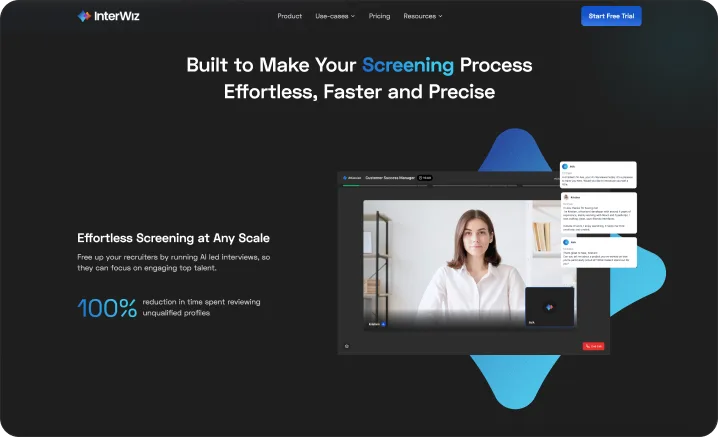
With InterWiz, recruiters can:
Screen directly against job descriptions, ensuring only candidates who meet role requirements move forward.
Add custom instructions for shortlisting, tailoring criteria to each role’s unique needs.
Shortlist based on interview templates and design, standardizing evaluations across all candidates.
Run structured AI-led interviews with transcripts and analytics, capturing both technical and soft skills.
Rank candidates with customizable weightings, giving recruiters a clear decision framework at the end of the process.
This end-to-end approach helps recruiters move from thousands of applications to structured, interview-ready shortlists. From there, they can make faster, data-backed hiring decisions without losing visibility into communication skills, collaboration, or cultural alignment.
Bottom Line: AI in High-Volume Tech Recruitment Process
AI-driven hiring enables staffing agencies and tech recruiters to screen developers up to 10x faster without losing fit, but only when it’s applied with transparency, fairness, and human oversight. The strongest results come from a hybrid approach: let AI tools handle the volume and repetition, while recruiters focus on judgment, communication, and culture. For teams under pressure to scale hiring, this combination means faster decisions, lower costs, and stronger long-term hires.
FAQs on AI for High-Volume Tech Hiring
Does AI really improve developer fit?
Yes, AI helps recruiters go beyond keyword matching by parsing context, ranking skills, and running adaptive coding assessments. When combined with structured interviews, it improves accuracy in selecting developers who not only qualify technically but also stay productive in the long term.
How do candidates perceive AI-led screening?
Candidate reactions depend on transparency. Surveys show skepticism when AI screening feels like a “black box,” but acceptance rises when recruiters explain how AI is used. Candidates value speed, fairness, and timely updates, areas where AI can enhance the process if recruiters communicate openly.
Which tools integrate best with ATS?
The best options are platforms that integrate seamlessly with applicant tracking systems and existing workflows. Coding assessment tools like HackerRank or Codility, and AI interview platforms like InterWiz, work effectively when paired with ATS solutions. InterWiz adds value by extending the workflow beyond shortlisting, offering structured interviews and analytics in the same environment.

High Quality Screening with AI Interviews
Automated interviews built for speed, scale, and accuracy.
🔥 Full features, no credit card required.